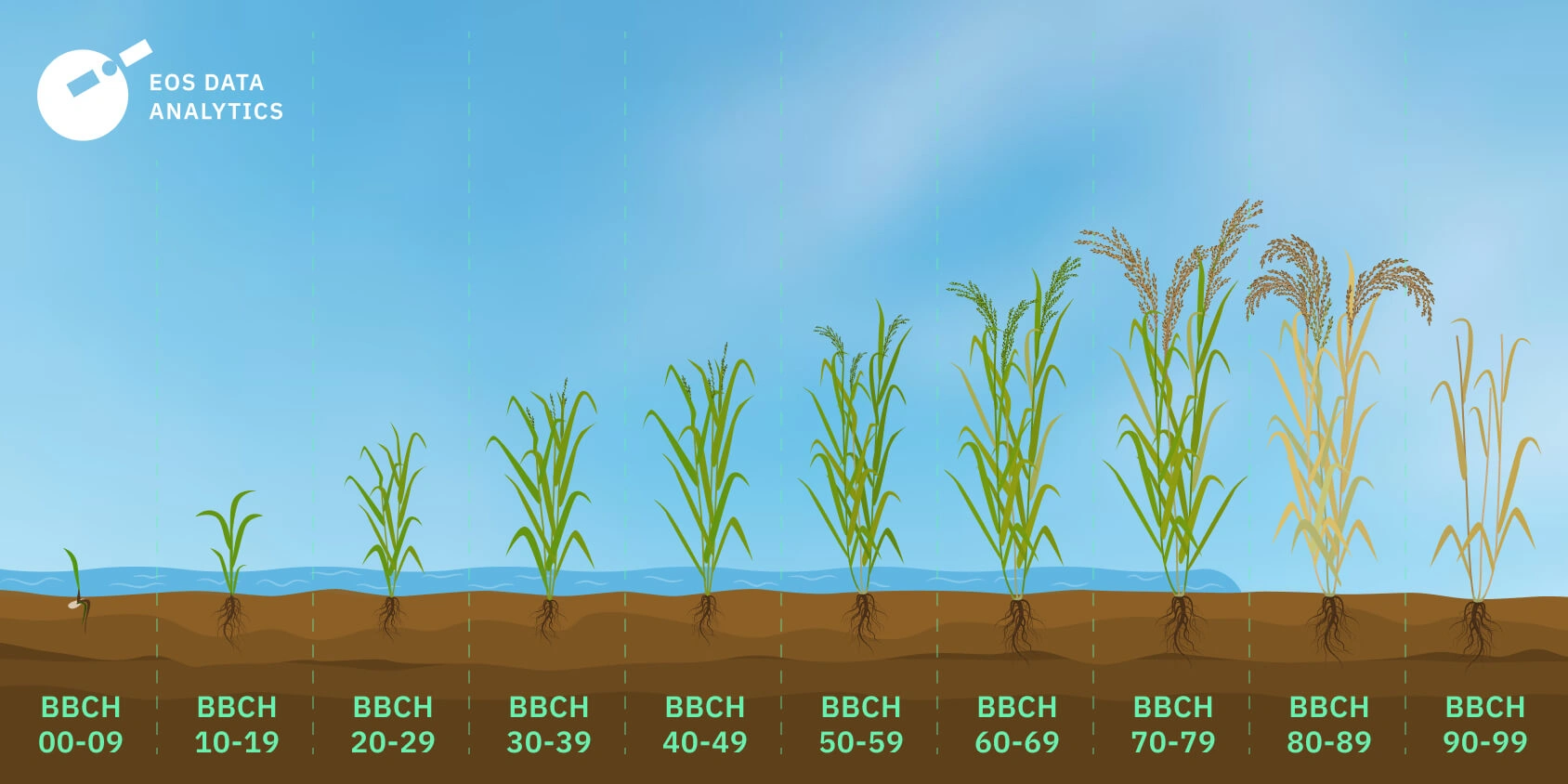
The recommendations provided in this article serve as general guidelines. Particular cultivation requirements may vary based on the unique conditions of each field and the selected hybrids.
Rice Growth Stages: Roadmap Of Timely Crop Management
Germination is the first step in the life cycle of rice, which ends when the grain matures and senesces. The duration and overlap of specific rice growth stages can differ based on the variety, environmental factors, and farming practices. Key yield determinants, such as panicle and spikelet number, filled grain count, weight, and percentage, are shaped at different stages of rice development. For this reason, picking the right times for different management procedures is crucial for adjusting the specific yield factor and achieving the target rice harvest quantity and quality.
Introduction To BBCH Growth Stages Of Rice
A leaf is considered unfolded in rice when its ligule or the tip of the next leaf is visible. If tillering or stem elongation begins before BBCH growth stage 13, proceed to BBCH growth stages 21 or 30, respectively. Also, bear in mind that flowering typically begins before the BBCH growth stage 55; therefore, keep going with the primary BBCH growth stage 6.
Growth stages of rice plants according to the BBCH scale
BBCH 00–09: Germination
Exposure to oxygen, moisture, and soil temperatures higher than 50°F (10°C) is necessary for a rice seed to germinate. Imbibition of a sufficient amount of water during this rice seed development stage triggers the activation of the embryo in the seed. Before applying the pre-emergent herbicides, it is crucial to let the seed soak up water to avoid damaging it. Also note that covering rice seeds with both dirt and water, resulting in oxygen deficiency prevents normal seedling emergence and further crop growth.
In the rice embryo, there is growth of the radicle and coleoptile, mostly through elongation. The coleoptile soon ceases its growth when subjected to sunlight. In aerobic conditions, the radicle will emerge earlier than the coleoptile, but in anaerobic conditions, the coleoptile will be the first to emerge. The appearance of coleoptile is a telltale sign of seedling emergence.
The ideal temperature for rice germination is 87°F (30°C), but it can happen anywhere from 50 to 107°F (10 to 41°C). In the temperature range of 70 to 97°F (21 to 36°C), the germination stage of rice usually lasts just two days. It takes longer and might result in a reduced emergence rate when the temperature is lower or higher than this.
Sowing rice at the optimal time, taking into account weather conditions, is crucial, as simply increasing the seeding rates will not make up for extreme temperatures and bad weather. EOSDA Crop Monitoring offers accurate field-by-field weather forecasts to help you select favorable sowing dates. On top of this, the platform provides farmers with easy access to historical weather data, empowering them to make well-informed decisions about the best time to sow seeds based on regional weather patterns. This well-thought-out approach reduces the risk of rice being affected by unfavorable weather conditions during germination while also helping ensure that throughout the growing season, the crop most likely receives the necessary moisture and heat for its best growth and yield.
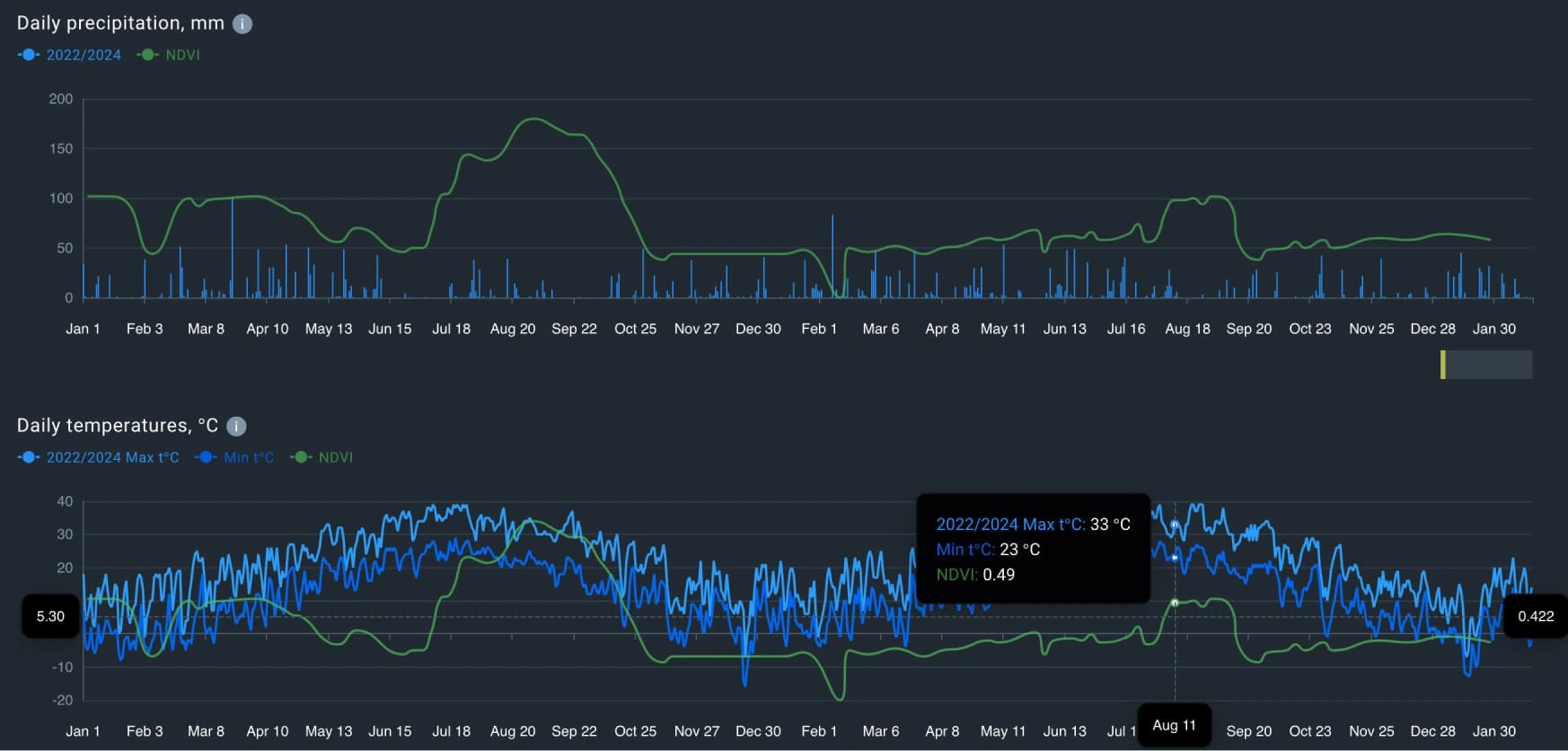
Phosphorus (P), which is essential for root growth, intense tillering, and early ripening, and potassium (K), which promotes root growth and makes the crop more resistant to diseases and pests, are both applied during the germination stage of rice growth. Use P-fertilizer and low-rate K-fertilizer before the final puddling ahead of transplanting seedlings, or topdress all the fertilizer 10–15 days following direct seeding . For precise fertilizer application, harness productivity maps in EOSDA Crop Monitoring. These maps provide a visual representation of vegetation trends across your field, allowing you to avoid excessive use of phosphorus and potassium fertilizers in areas where these nutrients may have built up over the years.
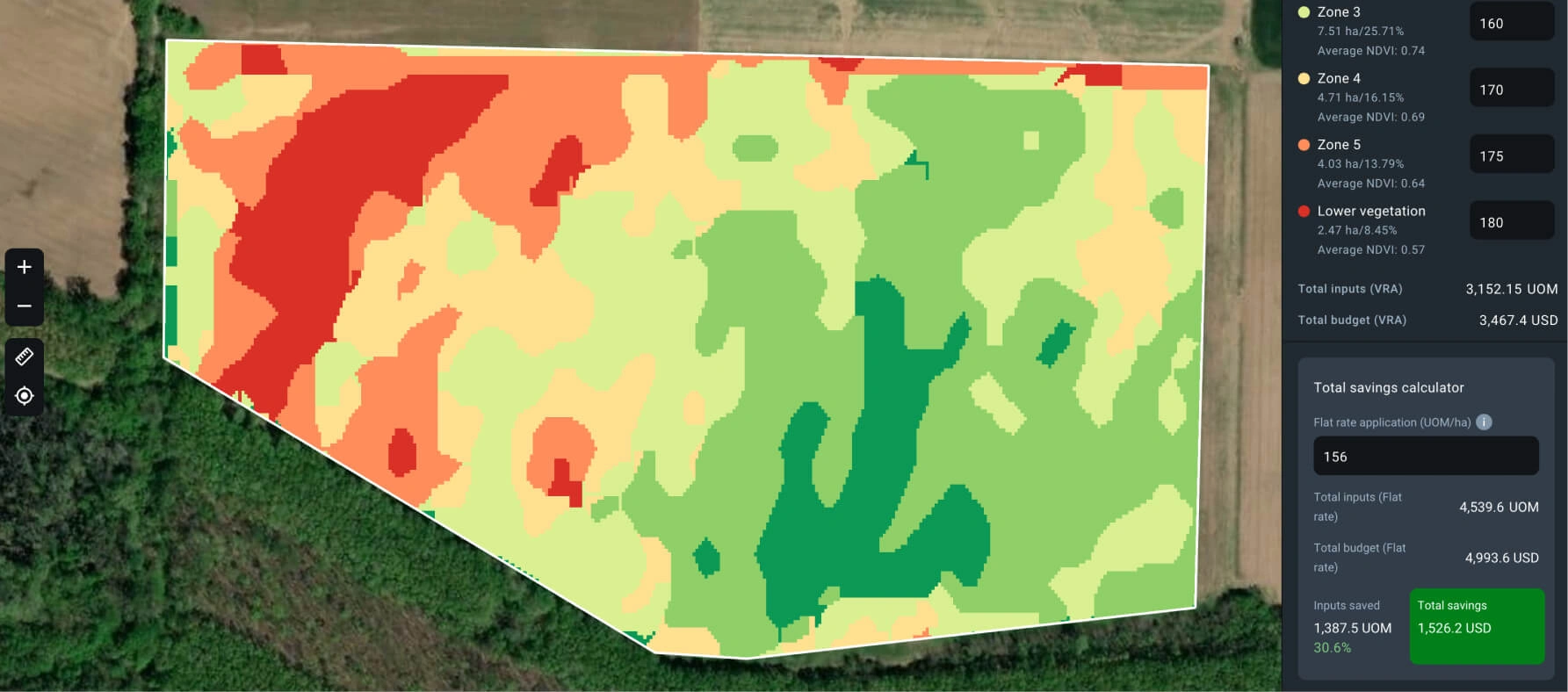
BBCH 10–19: Leaf Development
The first leaf to emerge from the coleoptile upon light exposure marks the beginning of the leaf development stage. Typically measuring about 1 inch (2.5 cm) or shorter, the primary leaf in rice serves as a protective covering for the following leaf that will emerge. There is one true leaf and one primary leaf in the one-leaf stage of rice growth. Each new leaf that grows after the first one is a true leaf.
The sheath and blade of the second true leaf are wider and longer than those of the first true leaf. After the ninth true leaf, the size of the leaves either stays the same or goes down, and this pattern continues for every successive leaf. While a rice plant has the potential to produce many leaves — roughly fifteen — the process of leaf senesce ensures that each shoot maintains a relatively constant number of four or five green leaves throughout the rice phenological growth stages.
During the leaf growth stage, the rice root system is also developing and beginning to shape. The primary and secondary root systems of water-seeded crops share the same ancestor. In rice sown directly into the soil, the primary root system begins its growth at or close to the seed, and the secondary system appears above the seed, emerging from the coleoptile’s base. These variations in rice root systems may impact nutrient delivery and other crop management decisions throughout rice growth stages.
The MSAVI vegetation index is a superior choice at the beginning of the growing season due to its enhanced consideration of soil cover, surpassing the capabilities of the NDVI and NDRE indices at this growth stage. With MSAVI, you can track the growth of rice plants from seed emergence through the leaf development stages and see if the process is going as expected.
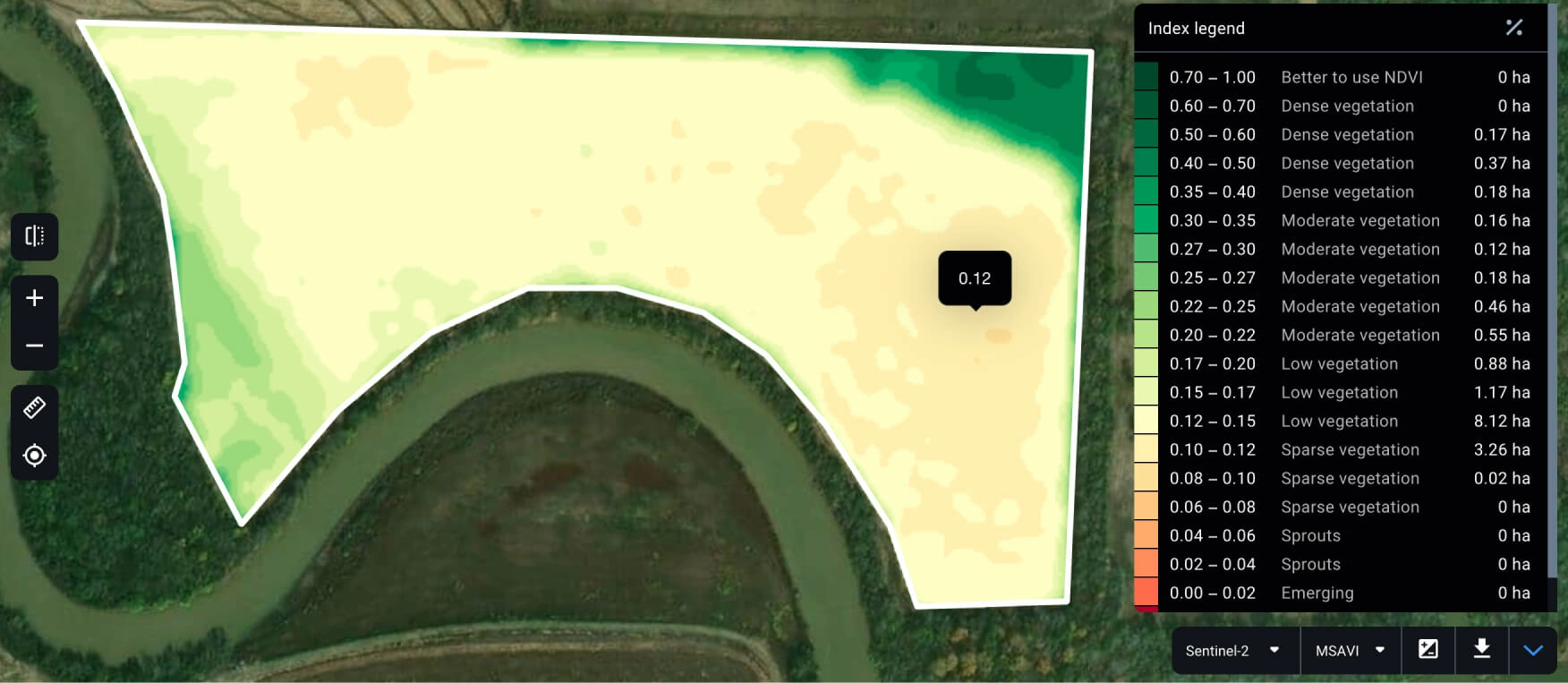
If the index’s value deviates from the norm, it will be necessary to take action, starting with dispatching a scout to the field to inspect the situation. When you need to pinpoint a specific region of the rice field to be inspected, the Scouting feature in EOSDA Crop Monitoring is a lifesaver. With this tool, a scout can also include all site photos and findings in the report.
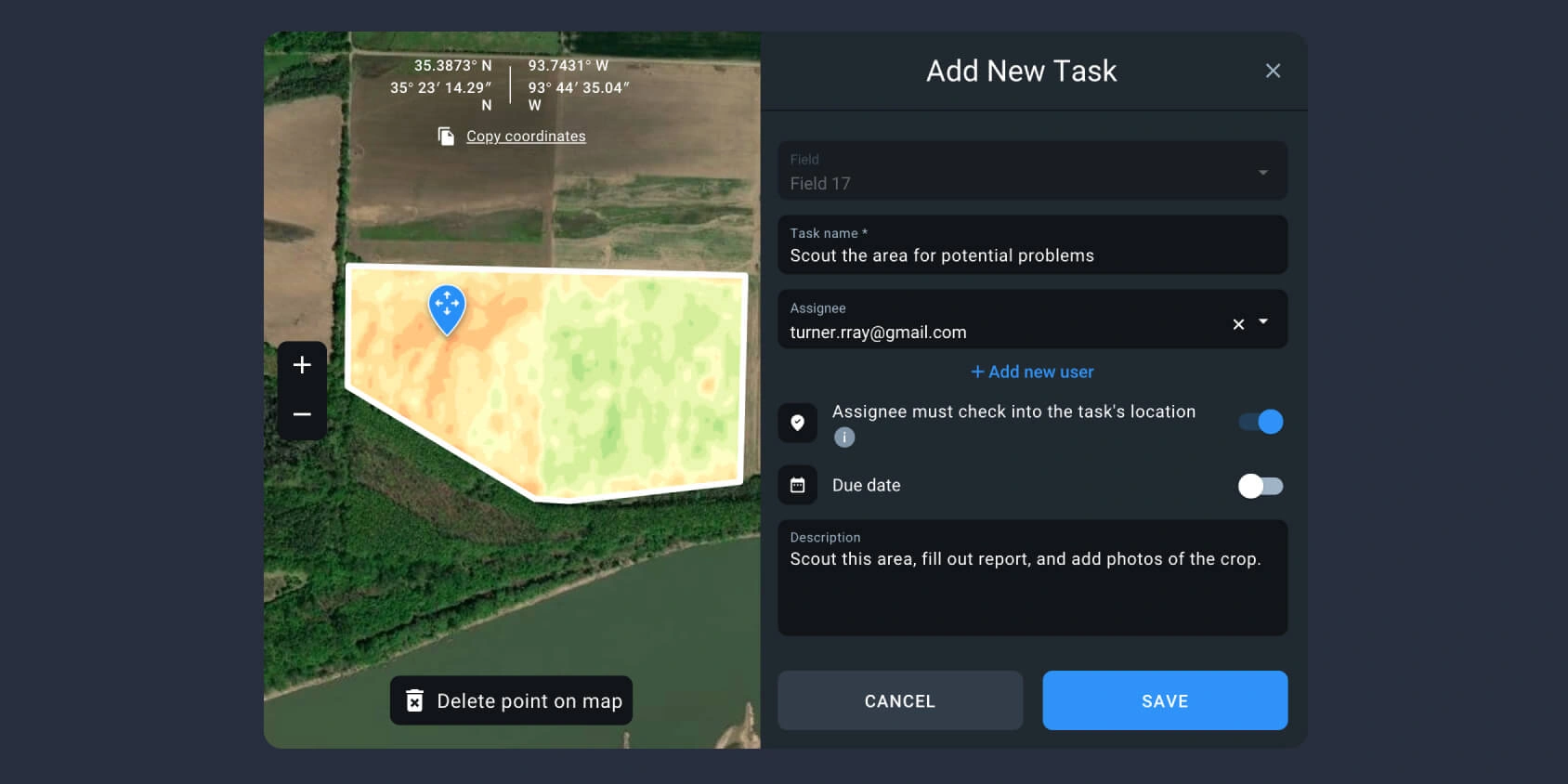
BBCH 20-29: Tillering
Rice tillers emerge from the tops of the sheaths of true leaves. Though tillers’ growth is not as quick or active as the main shoot’s, tillers follow the same development pattern. At this growth stage, the crown starts to form at the shoot base. Also, at this stage the growth and development of the roots and leaves is ongoing.
Emerging Of Tillers
The first tiller typically appears from the lateral bud of the second leaf on the stem at the BBCH 15 rice growth stage, marking the beginning of tillering. At the BBCH 16 growth stage, the process of tillering continues, with the second tiller emerging from the third leaf’s lateral bud. This is how tillering continues until the very last true leaf unfolds.
During the tillering stage of rice, it is best to apply ammonium nitrate to dry soil and flood it right away. If the conditions are wet, farmers may postpone N-fertilizing for a few weeks without sacrificing yield. However, if the situation persists, they have to apply fertilizer to the wet soil and flood it. The optimum application date might vary, but usually, it’s three weeks before you expect the panicles to differentiate.
In the early growth stages, before panicle development and all the way through the vegetative stages of rice growth, nitrogen is the most significant nutrient for the plant. That is why ensuring proper nitrogen application is crucial for promoting healthy rice growth. By analyzing vegetation indices, the VRA maps feature on EODA Crop Monitoring allows for the identification of areas in the field that require additional nitrogen fertilizer. With this map, you can easily implement variable rate nitrogen application technology on your paddies. Through the optimal distribution of fertilizer for each area of the field, you can efficiently allocate agricultural inputs for robust crop growth and minimize the risk of chemical leakage and pollution.
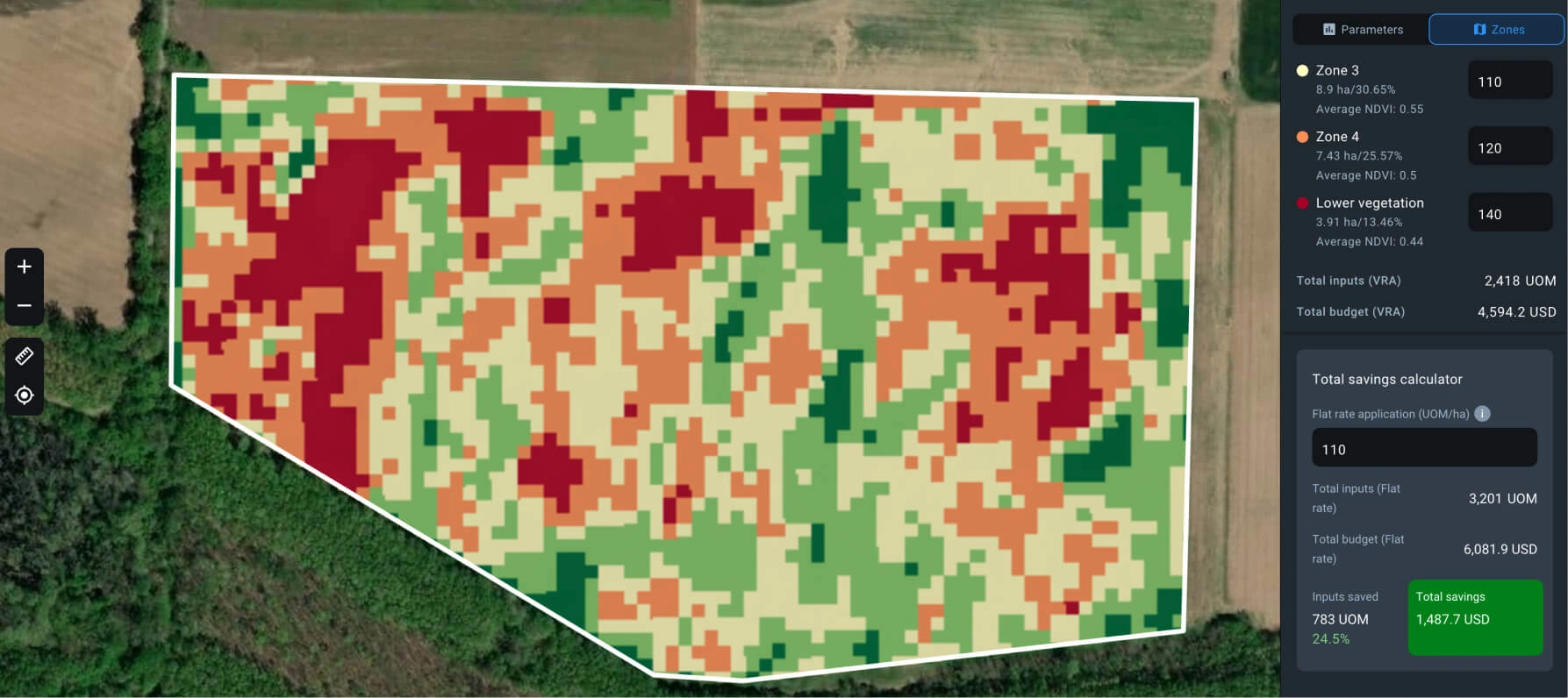
Active Tillering
Until the plant produces its maximum number of tillers, the rate of tillering grows along an S-shaped curve. At this critical growth stage of rice, the main stem and tiller could be difficult to tell apart. Direct-seeded rice with standard spacing will develop 2–5 panicle-bearing tillers per plant, whereas transplanted rice spaced further apart will usually yield 10–30 tillers. Once tillering has reached its maximum, no new effective tillers can be formed.
Additional lateral roots develop from the broadening crown surfaces at the active tillering growth stage. The roots that develop in rice now are larger than the seedling roots. As they grow older, these roots broaden and lengthen thanks to the availability of oxygen, light, and nutrients.
At the end of the tillering stage, rice might experience the vegetative lag, before entering the reproductive stages of rice development. Yellowing of plants is a common marker of this growth lag in midseason varieties. The majority of mass-produced cultivars, however, have a negligible vegetative lag time. The nitrogen need of the rice is low since the plant is not actively developing at this growth stage, so additional fertilization is not required.
EOSDA Crop Monitoring
Fields analytics based on high-resolution satellite images to track all the changes on-the-spot!
BBCH 30-39: Stem Elongation
At this growth stage, the rice plant starts growing in height thanks to the elongation of its main stem, comprised of nodes and internodes. The variety of rice determines the ultimate stem height. In particular, late-maturing varieties tend to be taller than early-maturing ones. The following processes occur during the stem elongation stage of rice growth.
Panicle Initiation
Rice enters its reproductive growth phase at the panicle initiation stage. The panicle is now either unnoticeable to the human eye or appears just as a green ring. The green ring stage is another name for the panicle initiation stage of rice because of this very reason. Internodes emerge right above the top node as green rings and are only visible for a few days.
It is important to start checking for sheath blight, a rice disease of global significance, right from the panicle initiation growth stage. With the EOSDA Crop Monitoring functionality, tracking and managing the disease becomes much easier. This is thanks to the inclusion of vegetation indices, particularly NDVI, which provides valuable insights at this growth stage. If the index values deviate from the expected range for the current stage of rice growth and development, it may indicate potential issues in the paddy, including crop diseases.
The most common conditions for sheath blight growth are nitrogen overfertilization, temperatures of 82–90°F (28–32°C), and rice canopy relative humidity of 85–100%. During rainy periods, plants are more likely to suffer from the disease. Thus, it’s crucial to keep an eye on variables like air temperature and precipitation in addition to the field’s vegetation cover. At times when the growth disease is the most likely, farmers should designate a scout to do regular spot checks on rice crops. EOSDA Crop Monitoring offers precise weather forecasts and a user-friendly Scouting feature, making it a reliable tool to support you in these tasks.
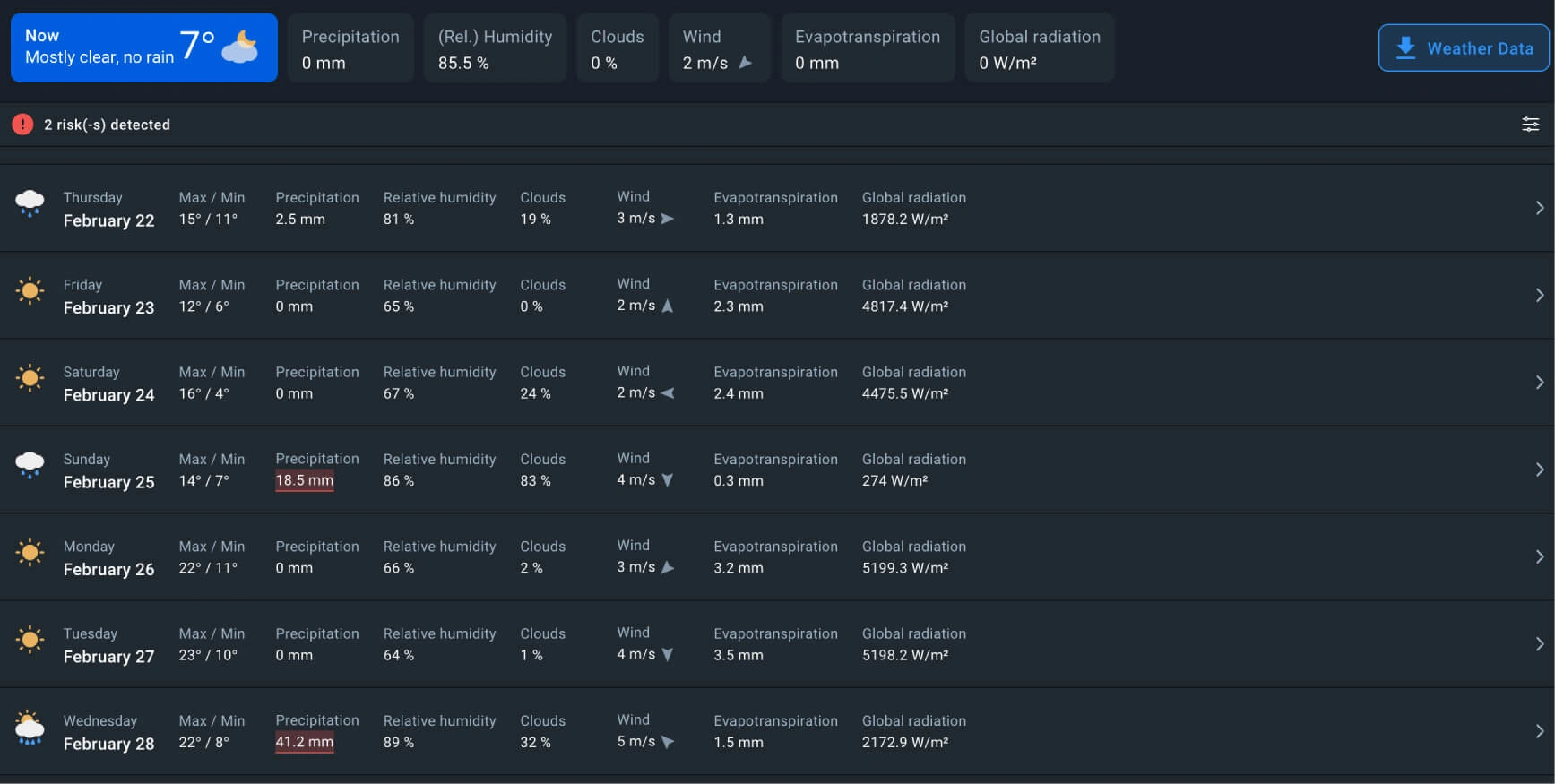
Internode Elongation
Beginning approximately seven days before the anticipated panicle differentiation, the internode elongation stage or rice growth continues until the plant reaches its maximum height, and then heading occurs. Stem internodes, as opposed to root ones, have a green tint to their walls.
In tall varieties, the internode length can range from 2 inches (5 cm) at the base to 15 inches (38 cm) at the top, whereas in semidwarf varieties, it can range from 1 inch (2.5 cm) to 10 inches (25 cm). These values may differ depending on planting date, soil condition, flood depth, plant density, weed competition, and other factors.
The majority of rice varieties currently being cultivated have a consistent number of internodes (5–6) above the main stem’s crown. Once stem internode elongation starts, the main shoot can only produce a maximum of six new full leaves (one per internode). The topmost leaf on a fully grown rice stem, known as the flag leaf, is the last to develop. The results of photosynthesis it provides are mostly responsible for the development of grains, which is why this leaf is highly esteemed.
When the growth of internodes above the crown starts, root extension reaches its climax. Now, the secondary root system has strongly branched out in every direction below the crown. It is also a period that indicates the beginning of the reproductive stages in rice.
Panicle Differentiation
The process of panicle differentiation in rice happens while the internode and panicle growth is ongoing. It’s now when the newly developed panicle becomes visible for the first time. The panicle has reached a length of around 0.12 inches (3 mm) and continues its growth within the stem.
In terms of management, the panicle length is the defining characteristic of this rice development stage. Fungicide labels often suggest applying the product “from a 2- to 4-inch panicle” (5- to 10-cm). When the panicle reaches around 4 inches (10 cm), you can discern individual florets on its most mature branches.
Rice plants are quite susceptible to environmental influences, and particularly heat stress, during this rice growth stage. To ensure the targeted number of grains per panicle, keep a close eye on these influences.
BBCH 40-49: Booting
During the booting stage of rice growth, the many components of a panicle mature within the protective sheath of the flag leaf. This sheath represents the boot. Three distinct stages of rice booting are defined by how much of the flag leaf sheath is visible above the penultimate leaf’s collar:
- Early boot. Starts from the moment a flag leaf’s collar is visible until it’s around 2 inches (5 cm) above the collar of the preceding leaf.
- Middle boot. The flag leaf’s collar shows up 2–5 inches (5–13 cm) above the preceding leaf’s collar.
- Late boot. The flag leaf’s collar shows up for a minimum of 5 inches (13 cm). As there’s an active growth of panicles by now, the boot swells, earning the name “swollen boot” for this growth stage. Environmental stresses on rice may now diminish grain yields.
BBCH 50-59: Inflorescence Emergence, Heading
The heading stage of rice growth begins once the panicle commences to emerge from the flag leaf’s bottom. Because tiller maturity varies, the heading of all plants in the field may take up to two weeks. The agronomical term “heading date” typically refers to the moment when half of the panicles have partially risen from the boot. This is not the same as the rice being “headed,” which occurs when all of the panicles have fully emerged. Keep in mind that some panicles may fail to fully exsert.
The typical duration between the heading and flowering growth stages is about two days. Variations in solar radiation, temperature, and humidity can cause significant changes in this duration. For example, when there is plenty of sunlight, it can be shortened to just one day. On the other hand, when it’s rainy and cloudy, it can be extended to 5–7 days.
BBCH 60-69: Flowering, Anthesis
The time between the floret’s opening and closure is known as the flowering stage of rice growth. The panicle branches start flowering at their tips and move all the way down to their bases. Pollen grains only have a five-minute viability after emerging, while the stigma has a fertilization window of three to seven days. Flowering might take about three weeks, depending on the maturity group of a rice variety and the temperature.
The majority of rice plants are self-pollinating. The quantity of fertilized flowers is the primary factor determining the filled grain potential of the panicle. But not every fertilized flower will fill because of the impact of certain growth conditions. Low temperatures under 50°F (10°C) for two nights in a row two weeks before or during the rice flowering stage and high temperatures over 95°F (35°C) during flowering can lead to blanking and sterility. Cold-induced sterility has a significantly higher impact on yield than heat-induced sterility. Sterility can be worsened by applying fertilizer or pesticides during flowering, as well as by strong winds and rainfall.
There is currently no way to mitigate heat and cold stress damage on rice plants. With crop insurance, though, you can safeguard your financial situation. Plus, you can prove the validity of your insurance claim with the weather data readily available in EOSDA Crop Monitoring.

BBCH 70-79: Development Of Fruits
Grain development characterizes the three- to six-day grain-filling stage in rice that follows ovum fertilization. Grain swells in response to starch and sugars moved from culms and leaves. Young rice grains grow from small flowers on the main stem. During this stage of rice development and growth, light intensity is a crucial factor since grains photosynthesize between 60% and 100% of their total carbon content .
At first, the consistency and color of rice starch are milky. The milk stage of rice growth is characterized by the appearance of milky starch buildup within the main stem’s florets. Because the florets that acquire starch become heavier, the panicle will eventually bend over. The endosperm starch goes from milky to firmer, like bread dough, when moisture content decreases. This marks the beginning of the dough stage in rice growth, which will be covered later on.
During this stage of rice growth, the weight of each grain is determined. The growth conditions can affect weight, even though it remains largely constant for a particular cultivar. High temperatures may cause a reduction in grain weight. Also, the rice grain-filling duration is longer at low temperatures and shorter at high ones. When temperatures remain below 50°F (10°C) for many days, grain filling usually slows down considerably and can even come to a halt after a heavy frost.
BBCH 80-89: Ripening
During this growth stage, the panicle transforms as the florets mature. While most rice varieties’ panicles are consistently pale green in the milk growth stage, they take on a patchwork of browns and greens as they reach the dough stage. At the same time, because of the buildup of carbohydrates in the florets during the ripening stage of rice growth, the grain shape and structure change.
The soft dough (BBCH 85) stage of rice growth is characterized by grains that can be dented without cracking. As the starch in the florets increasingly solidifies throughout the dough stage, the endosperm turns hard and chalky. The hard dough (BBCH 87) growth stage is brought about by a decrease in grain moisture content, which in turn increases grain hardness and fragility. There is a two- to five-day period between the BBCH 87 and BBCH 89 rice growth stages. At full ripeness (BBCH 89), the grain has completed its development and growth, and harvest time is approaching.
Ten to fifteen days prior to rice harvest, remove surface water for more even and timely ripening, easier harvesting, and simpler harvesting. Weather variables like temperature and precipitation may impact the exact timing of paddy draining. Leaving sufficient moisture in the soil is essential to prevent water stress in your crops during the rice ripening stage, which could negatively impact crop production and milling quality.
Large-scale rice producers can prevent any loss of grain quality and optimize the harvesting process thanks to EOSDA’s custom satellite-based solution for tracking harvest dynamics. Our technology makes it easy to access up-to-date information on a field’s projected yield and harvest progress at any given time. Stay updated on when each field was harvested and how many fields were harvested on a given date. With the use of cutting-edge satellite data and technology, you can rest assured that the rice harvest process is being carried out as intended to ensure the superior quality of the harvested product.
BBCH 90-99: Senescence
At maturity, the loss of water by the grain is the most important process in the panicle. With the loss of moisture during the last stages of rice growth, the hulls’ greenish hue disappears, and every grain’s endosperm turns into a consistently hard and translucent substance.
Nearly 27 days separate the ripeness (BBCH 89) and overripeness (BBCH 92) of rice. Since the later-developing grains are still filling up and the earlier-developing grains are drying out, the whole field of rice is often harvested before the BBCH 92 rice growth stage. Achieving high rice milling yields relies on uniform ripeness. In case of uneven ripeness, holding off until all of the grains fill typically leads to lower milling quality.
Rice production often ends up with a lot of crop residue. Since mechanized harvesting became commonplace, farmers have taken to burning crop residues, which were getting in the way of tillage and sowing for the next crop. However, soil organic matter (SOM) and nutrients are lost in this way. Mulching, surface residue retention, and no-till farming are alternative practices that shield the rich topsoil from erosion. The decision on the optimal management of rice residue should be based on the local climate and soil, environmental factors, and economic considerations.
About the author:
Vasyl Cherlinka is a Doctor of Biosciences specializing in pedology (soil science), with 30 years of experience in the field. He attended the engineering college in Ukraine and received his degree in agrochemistry, agronomy and soil science in the Chernivtsi National University. Since 2018, Dr. Cherlinka has been advising EOSDA on problems in soil science, agronomy, and agrochemistry.